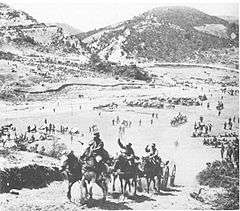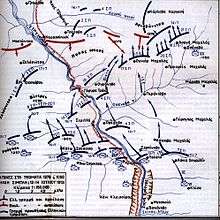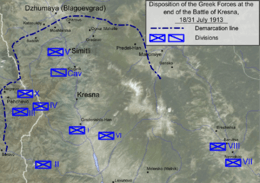Battle of Kresna Gorge
The Battle of Kresna Gorge was fought in 1913 between the Greeks and the Bulgarians during the Second Balkan War. It marked the last phase of the Greek advance into Bulgarian territory before the ceasefire and the following peace treaty.
| Battle of Kresna Gorge | |||||||
|---|---|---|---|---|---|---|---|
| Part of Second Balkan War | |||||||
 Greek units advancing in Kresna Gorge | |||||||
| |||||||
| Belligerents | |||||||
|
|
| ||||||
| Commanders and leaders | |||||||
|
Gen. Mihail Savov Gen. Nikola Ivanov | King Constantine I | ||||||
| Strength | |||||||
| 110 battalions | 80 battalions | ||||||
| Casualties and losses | |||||||
| 10,000[1] | |||||||
Background
After the Serbian front became static, and seeing that the Bulgarian Army in his front had already suffered defeat, King Constantine ordered the Greek Army to march further into Bulgarian territory and take the capital city of Sofia. King Constantine wanted a decisive victory on this war despite the objections of Prime Minister Eleftherios Venizelos who realized that the Serbs, having won their territorial objectives, were now trying to move the weight of the rest of the war to the Greeks by staying passive. The battle was continued for eleven days, between July 8–18, over a front of 20 km, in a maze of forests and mountains.
Conflict
Greek advance and breaking through the Kresna pass
After the victorious Battle of Doiran the Greek forces continued their penetration north. On July 18, the 1st Greek Division, managed to drive back the Bulgarian rear guard and captured an important foothold at the southern end of the Kresna pass.[2]
In the pass, the Greeks were ambushed by the Bulgarian 2nd and 4th Armies which was newly arrived from the Serbian front and had taken up defensive positions there. However, after bitter fighting the Greek side managed to break through the Kresna pass. The Greek advance continued and on July 25, the village of Krupnik, north of the pass, was captured, forcing the Bulgarian troops to withdraw to Simitli.[3] Simitli was also captured on July 26,[4] while at the night of July 27–28 the Bulgarian forces were pushed north to Gorna Dzhumaya (Blagoevgrad), 76 km south of Sofia.[5]
Meanwhile, the Greek forces continued their march inland into western Thrace and on July 26, entered Xanthi and the next day entered Komotini, without facing opposition.[5]
Bulgarian counterattack and armistice

The Greek army was stopped in front of Gorna Dzhumaya by significant Bulgarian resistance.[6][7] In July 28, the Greek forces resumed the attack and captured a line stretching from Cherovo to Hill 1378, southeast of Gorna Dzhumaya.[8]
However, on the evening of July 28, under heavy pressure, the Bulgarian army was forced to abandon the town, while it set fire to a quarter of it during the retreat.[9][10] On the following day, the counterattacking Bulgarians attempted to encircle the outnumbered Greeks in a Cannae-type battle by applying pressure on their flanks.[11] Nevertheless, the Greeks launched counter-attacks at Mehomia and to the west of Kresna and by July 30 the Bulgarian attacks had subsided somewhat. On the eastern flank, the Greek army launched an counterattack towards Mehomia through the Predela pass. The offensive was stopped by the Bulgarian army on the eastern side of the pass and fighting ground to a stalemate. On the western flank, an offensive was launched against Charevo Selo with the objection of reaching the Serbian lines. This failed and the Bulgarian army continued advancing, especially in the south, where by the 29th of July the Bulgarian forces had cut the Greek line of retreat through Berovo and Strumitsa, leaving the Greek army with only one route of retreat.[12][13][14] However, after a three days fighting at the sectors of Pehchevo and Mahomia, the Greek forces retained their positions.[15] On July 30, the Greek headquarters planned to launch a new attack in order to advance towards the sector of Gorna Dzhumaya.[16] On that day hostilities continued with the Bulgarian forces deployed on strategic positions north and northeast of the town.[17]

Meanwhile, King Constantine, who had neglected the initial Bulgarian requests for truce and wanted to capture Sofia, Bulgaria's capital, now informed Venizelos, that his army was "physically and morally exhausted" and urged him to seek cessation of hostilities[11] through Romanian mediation. The resulted general armistice, signed on July, 31 [O.S. July, 18] 1913 in Bucharest, ended one of the bloodiest battles of the Second Balkan War.
Legacy
Armistice left both parties claiming victory. From the Greek point of view, after 11 days of attack the Bulgarians had clearly failed to turn the Greek army's flanks, and consequently they consider the battle a defensive victory.[13] To the Bulgarians, the battle was a victory since their attack successfully stopped the Greek Army's advance towards Sofia and thus induced the Greeks to accept the proposed armistice. This view is supported by the opinion held by some historians that although the battle was ended inconclusively by the armistice, by the end of the war the Greek army was threatened by encirclement and annihilation.[11] The Greek side on the other claims that during the prolonged battle, the Bulgarians had progressively involved all available forces, and lacked the additional manpower to complete the encirclement of the Greek forces.
References
Citations
- Cassavetti, D. J. Hellas and the Balkan wars. T. Fisher Unwin, London 1914. р. 334
- Hellenic Army General Staff, Army History Directorate. [Ed. committee: Dimitrios Gedeon (1998). A concise history of the Balkan Wars, 1912–1913. Athens: Hellenic Army General Staff. p. 254. ISBN 9789607897077.
- Gedeon, Dimitrios (1998). A concise history of the Balkan Wars, 1912–1913 (1.udg. ed.). Athens: Hellenic Army General Staff. p. 257. ISBN 978-960-7897-07-7.
- Gedeon, Dimitrios (1998). A concise history of the Balkan Wars, 1912–1913 (1.udg. ed.). Athens: Hellenic Army General Staff. p. 259. ISBN 978-960-7897-07-7.
- Gedeon, Dimitrios (1998). A concise history of the Balkan Wars, 1912–1913 (1.udg. ed.). Athens: Hellenic Army General Staff. p. 260. ISBN 978-960-7897-07-7.
- History of the Bulgarians: The Military history of the Bulgarians from Ancient times until present day, Georgi Bakalov, 2007, p.450, (in Bulgarian)
- Historical overview, Volume 38, Issues 4–6, 1982, p.112 (in Bulgarian)
- Hellenic Army General Staff, Army History Directorate. [Ed. committee: Dimitrios Gedeon (1998). A concise history of the Balkan Wars, 1912–1913 (1.udg. ed.). Athens: Hellenic Army General Staff. p. 261. ISBN 9789607897077.
- Price, Crawfurd (1914). The Balkan cockpit. T. Werner Laurie LTD, p. 336
- Great Military and Naval Encyclopedia (in Greek). 6. Athens: Έκδοσις Μεγάλης Στρατιωτικής και Ναυτικής Εγκυκλοπαιδείας. 1929. p. 300. Retrieved 2 July 2012.
Αι περί των Βουλγάρων πληροφορίαι έφερον ότι εξαιρετική κίνησις οχημάτων παρουσιάζετο επί της Β. της Α. Τζ. Οδού, ότι τμήματα ισχυράς δυνάμεως μετεκινούντο εκ της δεξιάς προς την αριστεράν όχθην και ότι τέλος σοβαροί καταυλισμοί παρουσιάζοντο περί το υψ. 546, και περί τα 3 χλμ. Β. της Α. Τζ.. ήτις είχε πυρποληθή.
- Hall, Richard (2000). The Balkan Wars, 1912–1913: Prelude to the First World War. Routledge. pp. 121–122. ISBN 0-415-22946-4.
- History of the Bulgarians: The Military history of the Bulgarians from Ancient times until present day, Georgi Bakalov, 2007,p.452
- Price, Crawfurd (1914). The Balkan cockpit. T. Werner Laurie LTD.
- History of the Macedonian-Adrianopolitan Volunteer Corps, Petar Darvingov, 1925, book II, p.712-714 (in Bulgarian)
- Gedeon, Dimitrios (1998). A concise history of the Balkan Wars, 1912–1913 (1.udg. ed.). Athens: Hellenic Army General Staff. p. 261. ISBN 978-960-7897-07-7.
- Gedeon, Dimitrios (1998). A concise history of the Balkan Wars, 1912–1913 (1.udg. ed.). Athens: Hellenic Army General Staff. p. 262. ISBN 978-960-7897-07-7.
- Great Military and Naval Encyclopedia (in Greek). 6. Athens: Έκδοσις Μεγάλης Στρατιωτικής και Ναυτικής Εγκυκλοπαιδείας. 1929. p. 301. Retrieved 2 July 2012.
17 Ιουνίου: Κατά τη νύκτα το Γεν. Στρατ. του Ελλην. στρατού... βληθείσα εκ του Β. τούτου κείμενου δάσους, επέστρεψε μη περατώσασα την αποστολή της.
Bibliography
- Price W. H. Crawfurd. The Balkan Cockpit – The Political and Military Story of the Balkan Wars in Macedonia. Read Books, 2008. ISBN 978-1-4437-7404-8.
- Hall, Richard C. (2000). The Balkan wars 1912 – 1913 : prelude to the First World War (Repr. ed.). London [u.a.]: Routledge. ISBN 9780415229463.
| Wikimedia Commons has media related to Battle of Kresna Gorge. |